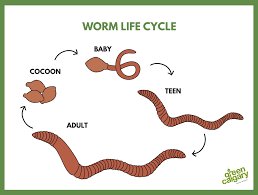
Now, just like every living creature, worm bin worms go through different stages of life, and each phase offers a window into their behaviors and needs. Imagine them like tiny superheroes of the compost world, each stage vital to their mission of transforming waste into fertile gold. So grab a cup of coffee, and let’s explore the fascinating life cycle of these little composting champions!
The Stages of a Worm’s Life Cycle
The life cycle of a worm can be broken down into several key stages: hatching, juvenile, adult, and reproductive stages. Each stage presents a unique phase in the worm’s development and behavior.
Hatching: The Beginning
Worms start their life as tiny eggs. In a worm bin, these eggs are laid in cocoons, which are small, tan, or brown capsules that can hold multiple eggs. Each cocoon might contain about 2 to 5 eggs, making it the perfect little nursery for baby worms. When conditions are just right—think moisture, temperature, and food—baby worms, or hatchlings, emerge from these cocoons.
These tiny wormlings are incredibly small, usually measuring just a few millimeters long. It’s a bit like seeing a newborn fish in a massive ocean! They are often translucent and can be hard to spot. During this stage, they’re focused on munching on soft, decaying material to build their strength.
Juvenile Stage: Growing Up
As the baby worms grow, they enter the juvenile stage, which can last for several weeks. During this time, they significantly increase in size and develop a more distinct wormy appearance. You might notice their bodies becoming darker and more elongated, transitioning from the delicate form of hatchlings to the robust frames of adult worms.
In this stage, they become more active composters. They feast on decomposing food waste, breaking it down more efficiently as they grow stronger. It’s fascinating to watch them burrow and tunnel through the compost, aerating it while searching for their next meal. At this point, they start to play an even bigger role in transforming kitchen scraps into nutrient-rich compost.
Adult Worms: The Composting Stars
After several weeks, the worms reach adulthood. They typically reach maturity in about 60 to 90 days, depending on their environment and food availability. Adult worms can grow up to 4 to 5 inches long, and they become full-time composting machines!
Here’s the thing: adult worms are not just about eating; they have unique behaviors. For instance, they tend to cluster together when they’re happy, often seen wriggling in tight groups. They are also great at communicating with each other through chemical signals, essentially “talking” about where the good food is or when they need to relocate.
Reproduction: The Cycle Continues
Once mature, worms can begin to reproduce, and this is where the magic happens. Worms are hermaphrodites, meaning each worm has both male and female reproductive organs. They mate by exchanging sperm, and after a short time, each worm will produce multiple cocoons.
This reproductive phase ensures a continuous cycle of life in your worm bin. With proper care, one worm can produce thousands of offspring in a year, which means your composting efforts only get better over time. They contribute not only to compost production but also to enriching the soil with vital nutrients, making your garden thrive.
Worm Behavior: Understanding Their Needs
Understanding the behaviors of worm bin worms helps in providing them the best living conditions possible. Healthy worms lead to better compost, which means healthier plants.
Feeding Habits
Worms are quite the eaters! You might be wondering what they like to munch on. They thrive on decomposing vegetable scraps, fruit peels, coffee grounds, and even shredded paper. It’s crucial to avoid feeding them dairy, meat, or oily foods, as these can attract pests or rot, putting your worms at risk.
When you feed your worms, mixing their scraps can create a more homogenous feeding environment. Think of it like making a smoothie; the more variety you add, the more delicious and nutritious it becomes. Regularly checking their food and adjusting as needed can keep them happy and healthy.
Preferred Environment
Worms are sensitive creatures. They prefer a moist, dark environment to thrive. Ideally, the temperature in the worm bin should be between 55°F to 77°F (13°C to 25°C). If it gets too hot or too cold, your worms can slow down or even die.
You can create a cozy space for them by adding bedding material like shredded newspaper or cardboard. It not only helps to keep moisture in but also provides a comfortable habitat for them to move around. Think of it as setting up the softest, coziest blanket fort for your little friends!
Signs of a Healthy Worm Bin
So, how can you tell that your worms are happy? A well-balanced worm bin should smell earthy—not foul or rotten. You should see active worms, healthy cocoons, and a rich, dark compost developing. If you notice your worms congregating at the top, they might be signaling that they need more food or some fresh bedding.
Sometimes, however, issues can arise. Overfeeding can lead to a smelly bin, while underfeeding can cause worms to eat through their bedding. Keeping an eye on your worms’ behavior can help you catch problems early, making it easier to maintain a healthy environment.
Worms are a lot more than just squiggly creatures in the dirt—they are essential players in the cycle of life, especially when it comes to composting. By understanding the life cycle of the worm bin worm, you can appreciate the remarkable transformation they create from waste to rich compost.
In summary, whether you’re a seasoned gardener or just starting your composting journey, knowing how these tiny superheroes grow and behave can help you create a thriving worm bin. With a little care and attention, you can transform your kitchen scraps into premium compost while supporting the natural ecosystem. So, go ahead and give those worms the love they deserve—your garden will thank you!
